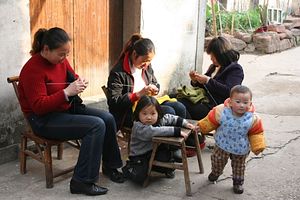As China’s top leaders plan a course for the next five year plan at this week’s fifth plenum, People’s Daily is taking a look back at one particular area that defied Communist Party predictions: China’s population growth.
As Chan Lu reports, the 12th Five Year Plan (covering the period from 2011-2015) said China’s total population should reach 1.39 billion in 2015, representing a growth rate of 7.2 percent. The actual figures for 2015 are likely to fall 15 million below that number – 2014 statistics had China’s population only growing by 5.2 percent.
That adds to rising concerns that China’s population may be aging more quickly than the Chinese government had predicted. Originally, Chinese officials that the population would peak around 2030 (as United Nations statistics estimated). Now, it seems clear that population decline will begin much sooner – in 2020, as the headline of Lu’s piece indicates. China’s famous one-child policy may have worked too well, leading to rock-bottom fertility levels that will be hard to overcome.
Andrew Mason, a professor of economics at the University of Hawaii, helped organize a team of researchers to tackle the question of when low fertility rates become a serious problem. The answer, as summarized in Mason’s op-ed for China Daily: “super-low fertility, a total fertility rate of 1.5 births or less, creates problems.” China’s fertility rate may already have dropped below that number – a 2012 article from Feng Wang, director of the Brookings-Tsinghua Center, in China Economic Quarterly found that “China’s total fertility rate… is among the lowest in the world, at only 1.4.”
Wang also notes that China’s leaders have overestimated their country’s population growth since the 10th Five Year Plan was released in 2001. That, Wang explains, may be partially because the main goal was in fact to control population growth – meaning lower-than-expected numbers were seen as an achievement by the government. But the repeatedly inflated figures may also explain why China is only now coming to terms with its demographic realities.
The People’s Daily report openly tackles the discrepancy. That the Communist Party’s official newspaper is addressing the subject adds credence to long-standing rumors that China will further relax its one-child policy this year. At the third plenum, in 2013, China announced a tweak to the plan that would allow couples to have two children provided one of the parents was an only child (prior to that, both parents had to be only children to be entitled to having two children). Now, rumor has it that China will simply move to a “two-child policy” across the board.
As Zhang Yi, a researcher at the Chinese Academy of Social Science, told People’s Daily, “The result of the current two-child policy yields a less than optimum number of applicants and production, so the original plan may be outdated and is subject to further modifications.”
The problem is that, so far, China’s loosened restrictions haven’t actually translated to increased population growth. As Lotus Yang Ruan pointed out for The Diplomat earlier this year, one a tiny fraction of the couples eligible to have a second child under China’s current policy have chosen to do so. Even a universal two-child policy is unlikely to slow China’s population decline; as Mason points out, “a two-child policy is guaranteed to produce fertility well below replacement fertility.” And it seems many Chinese couples, especially those in urban areas, are simply not interested in having large families (a trend reflected in developed countries around the world).
Thanks to that low fertility rate, China’s population is aging rapidly. According to South China Morning Post, from the end of 2013 to the end of 2014, China’s population between the ages of 16 and 59 – identified as the potential workforce – dropped by 3.7 million. Meanwhile, the over-60 demographic grew by over 10 million, and now represents 15.5 percent of China’s total population. China’s workforce will continue to shrink – and its elderly population will continue to rise, to a predicted 25 percent of China’s total population by 2030.
That trend has been obvious for some time, but the speed of the change seems to have caught Beijing by surprise. The question now is what new steps the Communist Party leadership will take to try and stem the tide of population aging and decline.

































